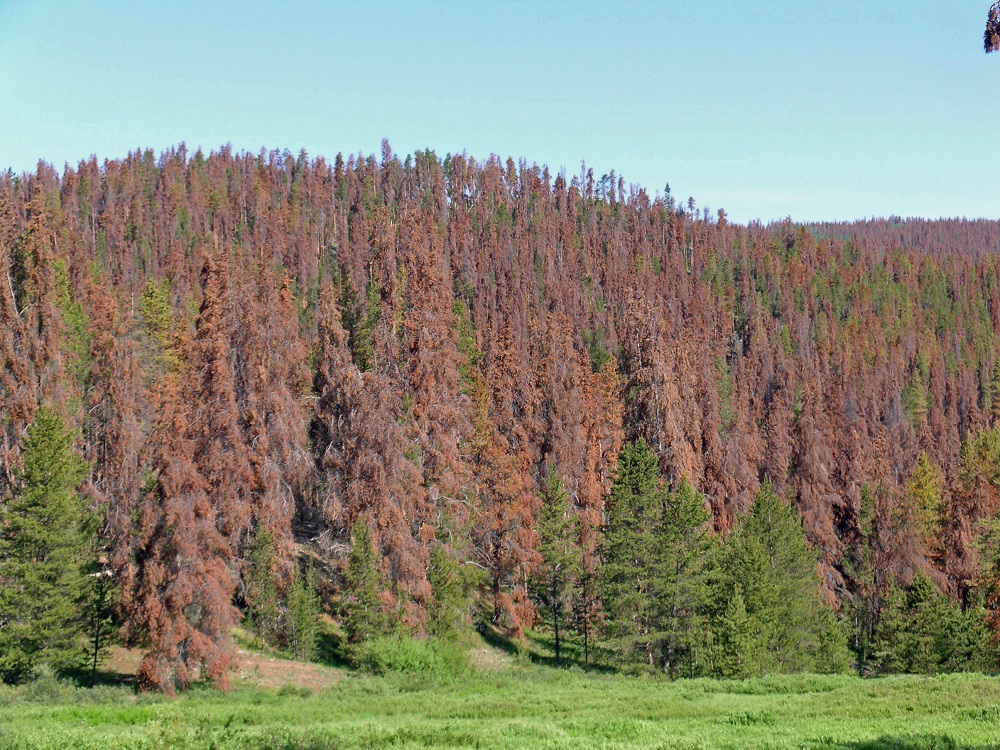Insect Outbreaks Kill Forests and Release Carbon

This Behind the Scenes article was provided to LiveScience in partnership with the National Science Foundation.
Insects are essential to a healthy forest environment, but bad bugs are bad news for forests. Throughout North America and the world, forests are experiencing some of the worst outbreaks of insects and diseases in recorded history.
As for the forests' future, researcher Jeffrey Hicke quips: "I'd rather be a beetle than a tree."
There are a cast of characters causing unprecedented levels of mortality to trees across millions of acres of North American forests, from the New Jersey Pine Barrens to the deserts of the Southwest.
One insect responsible for a staggering level of damage is the mountain pine beetle (Dendroctonus ponderosae). As the focus of much of Hicke's research, the mountain pine beetle is an aggressive bark beetle that can infest and kill lodgepole pine (Pinus contorta), limber pine (Pinus flexilis), whitebark pine (Pinus albicaulis), sugar pine (Pinus lambertiana) and bristlecone pine (Pinus longaeva).
Beetle alert
Major beetle outbreaks affect 30 million acres in the western United States and British Columbia, Canada. Hicke's team analyzed data from the United States and Canadian forest services, and estimated that since 1997, bark beetles have killed 6 billion trees. The culprit in 63 percent of the cases was the mountain pine beetle.
Get the world’s most fascinating discoveries delivered straight to your inbox.
Through his research at the University of Idaho, Hicke seeks to understand the causes and consequences of outbreaks. Hicke uses aerial surveys and data from satellites to spatially quantify the extent of outbreaks and determine their timing.
His efforts contribute to a wide collaboration of universities and are supported by the National Science Foundation, Department of Energy, Forest Service, National Oceanic and Atmospheric Administration, National Park Service and United States Geological Survey.
Driving outbreaks
Hicke's work and the work of others point to climate as a major driver of the outbreaks. Cold winters kill the mountain pine and other bark beetles and warmer winters help them survive. Because they allow beetles to complete life cycles within one year instead of two or more, warmer overall annual temperatures synchronize beetle populations for mass attacks on host trees.
Drought and high temperatures stress trees, which makes them more susceptible to beetle attack. For example, stressed pinyon pines are susceptible to engraver beetles (Ips confusus), which they normally withstand. In addition, insects and diseases are expanding into habitats previously too cold to be hospitable. For example, warming conditions have exposed high-elevation trees such as the whitebark pine to beetle attack. As a consequence, in 2011 the U.S. Fish and Wildlife Service added the whitebark pine to the list of candidate species eligible for Endangered Species Act protection.
Nonnative species also pose an increasing threat to forests. In recent decades, trade liberalization has allowed buyers and sellers to move goods more freely across borders. Harmful nonnative pests and diseases stow away in shipments of goods and are inadvertently introduced into new habitats. These introductions pose a major problem to native tree species that have not adapted to withstand these exotic pests.
Carbon costs
Outbreaks of forest insects and diseases have potentially dire consequences not just for the trees but also for critical ecosystem processes such as wildfire burning and carbon cycling.
Conserving and restoring forest carbon stocks is an important means of mitigating climate change. Healthy forests act as carbon sinks (natural or artificial reservoirs that accumulate and store carbon-containing chemical compounds), but outbreaks of insects and diseases can release this carbon from forests, turning them into carbon sources. Millions of fallen, decaying trees killed by the mountain pine beetle can be a significant source of carbon.
A 2008 study published in the journal Nature found that after a mountain pine beetle outbreak, the forest and its decaying trees gave off the carbon equivalent of five years of emissions from Canada's transportation sector.
The magnitude and duration of impacts of beetle outbreaks on the carbon cycling depend on a number of factors, the team concluded in a paper published Dec. 23 in the Journal of Geophysical Research-Biogeosciences.
Using remote sensing data and simulations postdoc Steve Edburg, Hicke and their collaborators were able to understand how insect outbreaks, carbon fluxes and climate change interact. Their models take multiple, interacting factors into account, and will enable forest managers to anticipate where outbreaks are likely to occur; this will help policy-makers to understand the implications of insects and diseases on climate change mitigation by forests.
Editor's Note: The researchers depicted in Behind the Scenes articles have been supported by the National Science Foundation, the federal agency charged with funding basic research and education across all fields of science and engineering. Any opinions, findings, and conclusions or recommendations expressed in this material are those of the author and do not necessarily reflect the views of the National Science Foundation. See the Behind the Scenes Archive.



